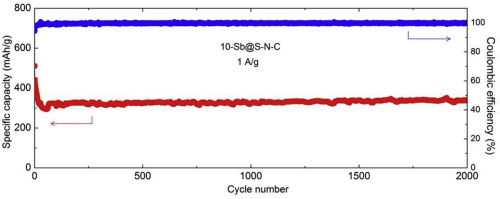徐翔星教授课题组在JOURNAL OF ALLOYS AND COMPOUNDS发表研究论文
Sb@S-N-C nanocomposite as long-cycle stable anode material for lithium ion batteries
Wang, C (Wang, Chong)[ 1 ] ; Chen, GY (Chen, Gaoyu)[ 1 ] ; Kou, JR (Kou, Juanrong)[ 1 ] ; Zhang, XJ (Zhang, Xianju)[ 1 ] ; Xu, XX (Xu, Xiangxing)[ 1 ]*(徐翔星); Bao, JC (Bao, Jianchun)[ 1 ] ; Shen, ZH (Shen, Zihan)[ 2 ] ; Jin, X (Jin, Xin)[ 2 ] ; Zhang, HG (Zhang, Huigang)[ 2 ]*; Liu, L (Liu, Li)[ 3 ] ; Yu, KH (Yu, Kehan)[ 3 ]*
[ 1 ] Nanjing Normal Univ, Sch Chem & Mat Sci, Jiangsu Key Lab Biofunct Mat, Nanjing 210046, Jiangsu, Peoples R China
[ 2 ] Nanjing Univ, Natl Lab Solid State Microstruct, Collaborat Innovat Ctr Adv Microstruct, Coll Engn & Appl Sci,Inst Mat Engn, Nanjing 210093, Jiangsu, Peoples R China
[ 3 ] Nanjing Univ Posts & Telecommun, Coll Elect & Opt Engn, Nanjing 210023, Jiangsu, Peoples R China
JOURNAL OF ALLOYS AND COMPOUNDS,202001,814
Antimony (Sb) is a competitive candidate for lithium ion batteries (LIBs) as anode material because of its high theoretical discharge capacity (660 mAh/g). However, it remains a challenge caused by the volume change in the process of charge and discharge, which would damage the Sb anode that lead to poor rate performance and low cycle stability. Herein, we report the synthesis of Sb@S-N-C nanocomposite as the anode material to solve the problem. First, SbSI nanowires with diameter of similar to 10 nm were synthesized. Then the SbSI nanowires were coated with polypyrrole (PPy) to form SbSI@PPy core-shell nanowires. By thermal reduction of SbSI@PPy, Sb@S-N-C nanocomposite was formed. Using the Sb@S-N-C nanocomposite as the anode material, a capacity of 536 mAh/g was obtained in 100 cycles at 0.5 A/g. Excitingly, it also exhibited superior reversible and long-cycle non-decay stability with the capacity of 342 mAh/g in 2000 cycles at a high current density of 1A/g.

文章链接:
https://www.sciencedirect.com/science/article/pii/S0925838819334073?via%3Dihub
版权与免责声明:本网页的内容由收集互联网上公开发布的信息整理获得。目的在于传递信息及分享,并不意味着赞同其观点或证实其真实性,也不构成其他建议。仅提供交流平台,不为其版权负责。如涉及侵权,请联系我们及时修改或删除。邮箱:sales@allpeptide.com